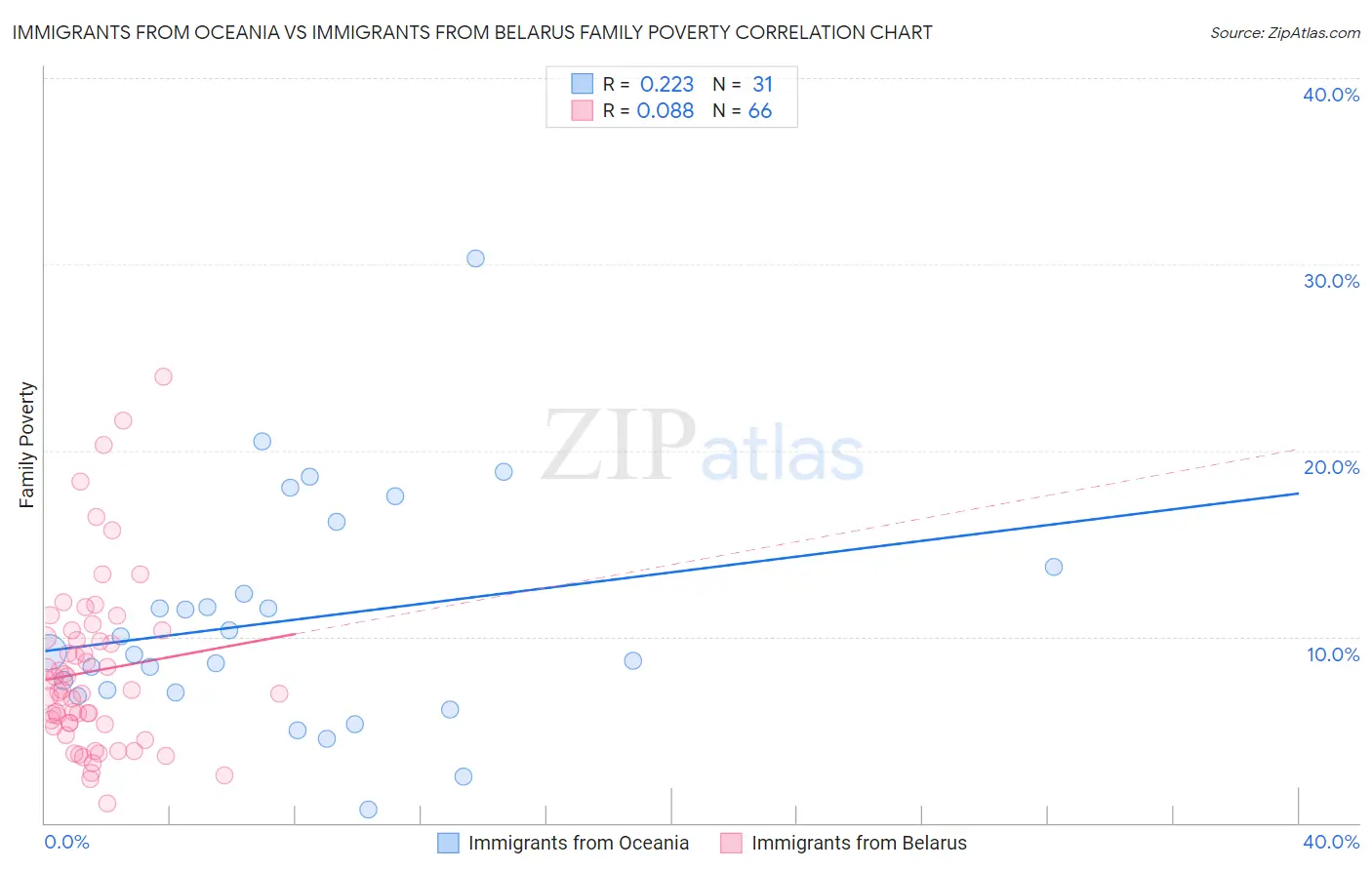Immigrants from Oceania vs Immigrants from Belarus Family Poverty
COMPARE
Immigrants from Oceania
Immigrants from Belarus
Family Poverty
Family Poverty Comparison
Immigrants from Oceania
Immigrants from Belarus
8.7%
FAMILY POVERTY
71.2/ 100
METRIC RATING
156th/ 347
METRIC RANK
8.5%
FAMILY POVERTY
83.2/ 100
METRIC RATING
146th/ 347
METRIC RANK
Immigrants from Oceania vs Immigrants from Belarus Family Poverty Correlation Chart
The statistical analysis conducted on geographies consisting of 304,831,685 people shows a weak positive correlation between the proportion of Immigrants from Oceania and poverty level among families in the United States with a correlation coefficient (R) of 0.223 and weighted average of 8.7%. Similarly, the statistical analysis conducted on geographies consisting of 150,053,959 people shows a slight positive correlation between the proportion of Immigrants from Belarus and poverty level among families in the United States with a correlation coefficient (R) of 0.088 and weighted average of 8.5%, a difference of 2.4%.

Family Poverty Correlation Summary
| Measurement | Immigrants from Oceania | Immigrants from Belarus |
| Minimum | 0.73% | 1.0% |
| Maximum | 30.3% | 24.0% |
| Range | 29.6% | 22.9% |
| Mean | 10.9% | 8.1% |
| Median | 9.1% | 7.1% |
| Interquartile 25% (IQ1) | 7.0% | 5.3% |
| Interquartile 75% (IQ3) | 13.8% | 9.9% |
| Interquartile Range (IQR) | 6.7% | 4.7% |
| Standard Deviation (Sample) | 6.1% | 4.6% |
| Standard Deviation (Population) | 6.0% | 4.6% |
Demographics Similar to Immigrants from Oceania and Immigrants from Belarus by Family Poverty
In terms of family poverty, the demographic groups most similar to Immigrants from Oceania are Tsimshian (8.8%, a difference of 0.30%), White/Caucasian (8.8%, a difference of 0.34%), Immigrants from Kuwait (8.7%, a difference of 0.40%), Peruvian (8.8%, a difference of 0.50%), and Hungarian (8.8%, a difference of 0.64%). Similarly, the demographic groups most similar to Immigrants from Belarus are Immigrants from South Eastern Asia (8.5%, a difference of 0.010%), Albanian (8.5%, a difference of 0.030%), Immigrants from Jordan (8.5%, a difference of 0.030%), Immigrants from Germany (8.5%, a difference of 0.050%), and Yugoslavian (8.5%, a difference of 0.080%).
| Demographics | Rating | Rank | Family Poverty |
| Immigrants | Ukraine | 83.9 /100 | #141 | Excellent 8.5% |
| Yugoslavians | 83.5 /100 | #142 | Excellent 8.5% |
| Immigrants | Germany | 83.3 /100 | #143 | Excellent 8.5% |
| Albanians | 83.3 /100 | #144 | Excellent 8.5% |
| Immigrants | South Eastern Asia | 83.2 /100 | #145 | Excellent 8.5% |
| Immigrants | Belarus | 83.2 /100 | #146 | Excellent 8.5% |
| Immigrants | Jordan | 83.0 /100 | #147 | Excellent 8.5% |
| Scotch-Irish | 82.2 /100 | #148 | Excellent 8.6% |
| Mongolians | 80.4 /100 | #149 | Excellent 8.6% |
| Syrians | 80.3 /100 | #150 | Excellent 8.6% |
| Brazilians | 80.1 /100 | #151 | Excellent 8.6% |
| Samoans | 79.8 /100 | #152 | Good 8.6% |
| Immigrants | Spain | 79.1 /100 | #153 | Good 8.6% |
| Immigrants | Vietnam | 75.4 /100 | #154 | Good 8.7% |
| Immigrants | Kuwait | 73.6 /100 | #155 | Good 8.7% |
| Immigrants | Oceania | 71.2 /100 | #156 | Good 8.7% |
| Tsimshian | 69.3 /100 | #157 | Good 8.8% |
| Whites/Caucasians | 69.1 /100 | #158 | Good 8.8% |
| Peruvians | 68.0 /100 | #159 | Good 8.8% |
| Hungarians | 67.2 /100 | #160 | Good 8.8% |
| Immigrants | Northern Africa | 66.9 /100 | #161 | Good 8.8% |